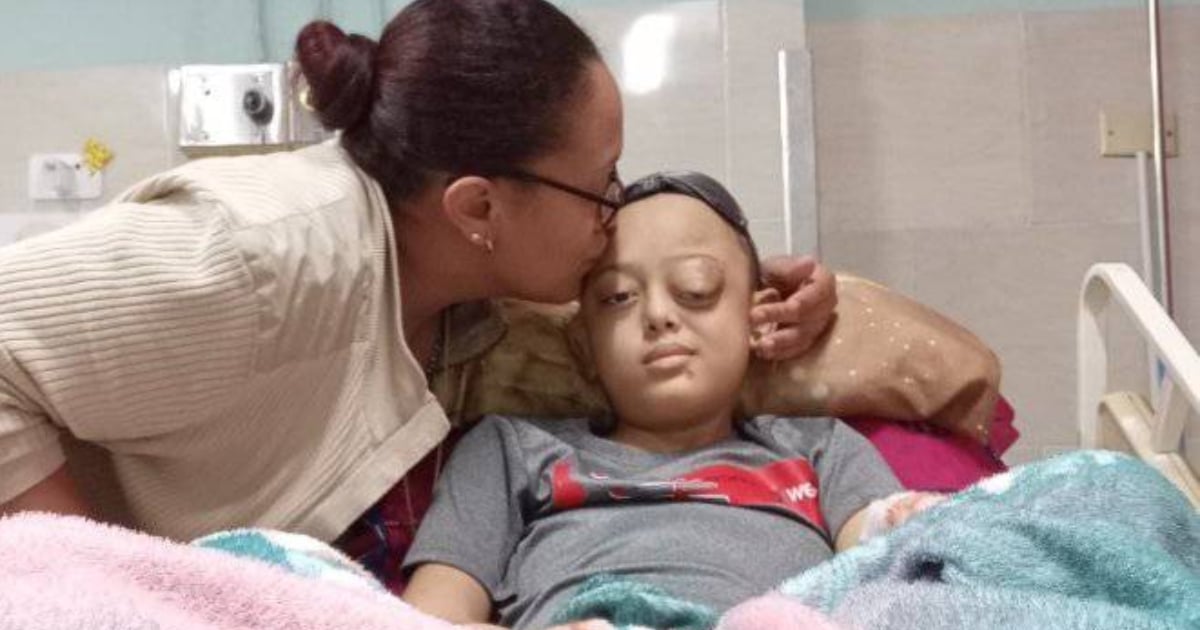The Cuban regime intends to use the case of the child Damir Ortiz Ramírez as an example of its healthcare system. The 10-year-old boy suffers from a serious illness and requires specialized treatment that is not available on the island, but the government denies his transfer to another country under the pretext that it could worsen his condition.
The minor and his mother, Eliannis Ramírez, went to the United States Embassy in Havana on Thursday to request a humanitarian visa after a hospital in Miami agreed to treat him, but the diplomatic mission denied the visa due to the lack of documentation issued by the Ministry of Public Health (MINSAP).
Damir was diagnosed with neurofibromatosis type 1 and has a plexiform neurofibroma in his right eye, in addition to a possible leukemia under investigation.
Following the publicity that his case has gained on the Internet, the government shared an editorial emphasizing that it serves as an example of specialized medical care and the resources invested in complex cases.
“Since the onset of his illness, the child has received specialized medical care. He has also had access to high-tech diagnostic methods, such as a high-field Magnetic Resonance Imaging (…) The Ministry of Public Health of Cuba acquired the corresponding one-year treatment of Koselugo (selumetinib), the first and only drug directed at treating NF 1, worth 500 thousand dollars,” reports on the government spokesperson portal “Razones de Cuba.”
According to the government, the family has always been informed about the diagnosis, progression, treatments, and life expectancy of the boy.
“Due to the complexity of the illness and the guarded nature of the diagnosis, the patient is not considered for transfer; as it would pose, among other risks, the possibility of a cardio-respiratory arrest, along with other complications that could lead to death,” he adds.
The last few days have been distressing for Damir’s mother, who is currently in intensive care at the Juan Manuel Márquez Pediatric Hospital in Havana, suffering from kidney damage and inflammation in both eyes.
According to activist Yamilka Laffita (Lara Crofs), the medical staff initially refused to provide her with a wheelchair. Finally, the mother managed to get the wheelchair in the room; thus began another odyssey, the process of arranging the ambulance transfer to the U.S. Embassy.
Diasniurka Salcedo Verdecia, an activist based in the United States, is organizing a fundraising campaign on GoFundMe to cover the expenses for treatment and travel, with a goal of $40,000.
Diasniurka emphasized that Damir could receive treatment at a hospital in Miami, where he will have access to therapies that are not available in Cuba. Eliannis, his mother, has repeatedly highlighted the precariousness and lack of resources in the Cuban healthcare system.
The case of Damir came to public attention in August 2023. His mother has fought through every possible avenue to get the little boy surgery, but there has been no response from the doctors.
The child’s tumor has spread to inoperable areas of the brain, according to Cuban neurosurgeons. Eliannis Ramírez has published several criticisms of the public health system and the bureaucracy that hinders medical care on the Island.
The case has sparked a wave of solidarity within the Cuban community and among human rights activists, who continue to demand responses from MINSAP and international support to save Damir’s life.
Frequently Asked Questions about the case of the Cuban child Damir Ortiz Ramírez and the healthcare system in Cuba
Why does the Cuban government deny the transfer of Damir Ortiz to the United States?
The Cuban government claims that Damir’s transfer could worsen his health condition, citing risks such as cardiac-respiratory arrest. However, activists and the child’s mother assert that he is being denied more specialized treatment that is unavailable in Cuba.
What illness does Damir Ortiz Ramírez suffer from and what treatment does he require?
Damir Ortiz Ramírez suffers from neurofibromatosis type 1 and has a plexiform neurofibroma in his right eye, as well as a possible leukemia under investigation. He requires specialized treatment that is not available in Cuba, and a hospital in Miami has agreed to treat him, offering therapies that he cannot receive on the island.
What is the Cuban regime’s stance on the healthcare system in the case of Damir?
The Cuban regime aims to present Damir’s case as an example of its healthcare system, highlighting the resources invested in his treatment. However, the family and activists criticize the lack of resources and the bureaucracy that hinder adequate medical care.
What obstacles does Damir’s family face in obtaining a humanitarian visa?
Damir’s family has been unable to obtain the humanitarian visa due to the lack of documentation from the Ministry of Public Health of Cuba (MINSAP). Although a hospital in Miami has agreed to treat Damir, MINSAP refuses to provide the necessary letter to process the visa.
How has the international community reacted to Damir’s case?
The case of Damir has generated a wave of solidarity among the Cuban community and human rights activists. A fundraising campaign has been organized on GoFundMe to cover the costs of treatment and travel, demonstrating support and demands for answers from the MINSAP and international support to save Damir’s life.
link

